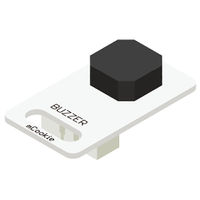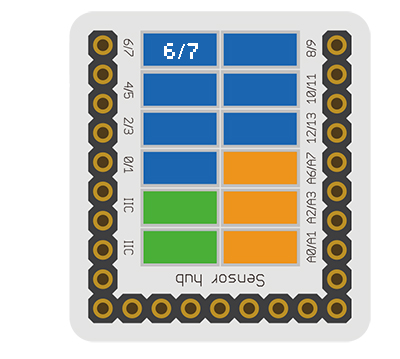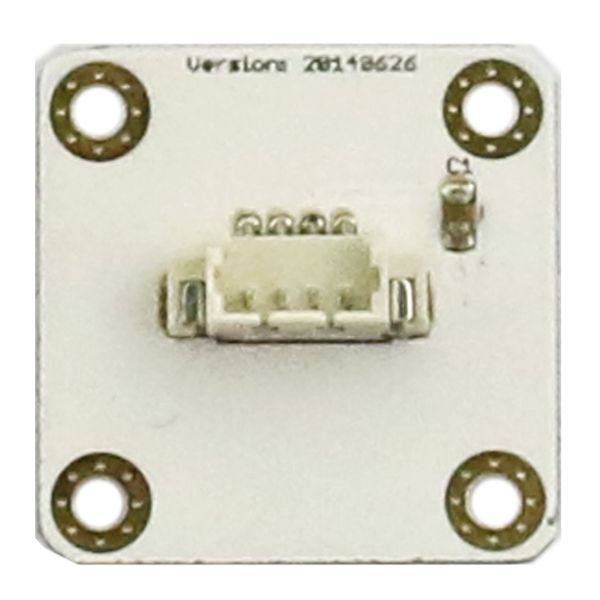Difference between revisions of "Sensor-Buzzer"
(→Usage) |
(→Usage) |
||
| (9 intermediate revisions by the same user not shown) | |||
| Line 60: | Line 60: | ||
<tab name="Arduino for Microduino" style="width:100%;"> | <tab name="Arduino for Microduino" style="width:100%;"> | ||
==Introduction== | ==Introduction== | ||
| − | The | + | The Buzzed Trinket is used as an output pin. Special functions on the Core module is used to generate a frequency signal to the Buzzer. |
==Key Functions== | ==Key Functions== | ||
*Required Libraries: None | *Required Libraries: None | ||
*Key Functions: | *Key Functions: | ||
| − | ** ''' | + | ** '''tone(pin_number, frequency)''' - starts generating a frequency signal on the pin, will not stop until noTone(pin_number) is called '''([https://www.arduino.cc/en/Reference/Tone Read more])''' |
***'''pin_number''' - is the pin number that the trinket is connected to | ***'''pin_number''' - is the pin number that the trinket is connected to | ||
| − | ***''' | + | ***'''frequency''' - a frequency value to generate on the pin |
| − | ** ''' | + | ** '''noTone(pin_number)''' - stops generating a frequency on the pin '''([https://www.arduino.cc/en/Reference/noTone Read more])''' |
***'''pin_number''' - is the pin number that the trinket is connected to | ***'''pin_number''' - is the pin number that the trinket is connected to | ||
| + | ** '''tone(pin_number, frequency, duration)''' - generates a frequency signal on the pin for a set amount of time '''([https://www.arduino.cc/en/Reference/Tone Read more])''' | ||
| + | ***'''pin_number''' - is the pin number that the trinket is connected to | ||
| + | ***'''frequency''' - a frequency value to generate on the pin | ||
| + | ***'''duration''' - the duration in milliseconds to generate the frequency signal | ||
==Example== | ==Example== | ||
| − | This is a simple example which | + | This is a simple example which: |
| + | *Starts the Buzzer at a 440hz frequency. | ||
| + | *Waits 1 second. | ||
| + | *Turns off the Buzzer. | ||
| + | *Wait 1 second. | ||
| + | *Runs the Buzzer at a 294hz frequency for 2 seconds | ||
| + | *Waits 5 seconds. | ||
'''Note''': Important lines of code are highlighted. | '''Note''': Important lines of code are highlighted. | ||
| − | <syntaxhighlight lang="cpp" highlight="1,2, | + | <syntaxhighlight lang="cpp" highlight="1,2,14,15,18,19,24,25"> |
| − | //Define the pin the | + | //Define the pin the buzzer is connected to |
| − | const int | + | const int BUZZER_PIN = 6; |
void setup() { | void setup() { | ||
| Line 84: | Line 94: | ||
//Initial serial communication port at 9600 baud | //Initial serial communication port at 9600 baud | ||
Serial.begin(9600); | Serial.begin(9600); | ||
| − | |||
| − | |||
| − | |||
} | } | ||
| Line 92: | Line 99: | ||
// put your main code here, to run repeatedly: | // put your main code here, to run repeatedly: | ||
| − | // | + | //Start the Buzzer with a 440hz frequency |
| − | + | tone(BUZZER_PIN, 440); | |
| + | //Wait 1 second | ||
| + | delay(1000); | ||
| + | //Turn off the Buzzer | ||
| + | noTone(BUZZER_PIN); | ||
| − | // | + | //Wait 1 second |
delay(1000); | delay(1000); | ||
| − | // | + | //Run the Buzzer with a 294hz frequency for 2000 milliseconds (2 seconds) |
| − | + | tone(BUZZER_PIN, 294, 2000); | |
| − | // | + | //Wait 5 seconds |
| − | delay( | + | delay(5000); |
} | } | ||
</syntaxhighlight> | </syntaxhighlight> | ||
| Line 109: | Line 120: | ||
Download the above example: n/a | Download the above example: n/a | ||
</tab> | </tab> | ||
| + | |||
===Program Download=== | ===Program Download=== | ||
*Download and unzip the program '''[[File:Sensor-Buzzer_Test.zip]]''' | *Download and unzip the program '''[[File:Sensor-Buzzer_Test.zip]]''' | ||
Latest revision as of 20:15, 18 August 2017
| Language: | English • 中文 |
|---|
|
The product number of Sensor-Buzzer is: MSDO11 Sensor-Buzzer is a passive buzzer. Like a magnetic speaker, it needs voltage with different frequency so that it can make sound accordingly. The pitch becomes louder when the frequency gets higher. ContentsIntroduction of Pins
Features
Specification
Document
UsageBasic FunctionalityThe Buzzer Trinket is a simple trinket which emits sound when passed with a frequency. A Core module can control the frequency of the Buzzer output.
ProgrammingIntroductionThe Buzzed Trinket is used as an output pin. Special functions on the Core module is used to generate a frequency signal to the Buzzer. Key Functions
ExampleThis is a simple example which:
Note: Important lines of code are highlighted. //Define the pin the buzzer is connected to
const int BUZZER_PIN = 6;
void setup() {
// put your setup code here, to run once:
//Initial serial communication port at 9600 baud
Serial.begin(9600);
}
void loop() {
// put your main code here, to run repeatedly:
//Start the Buzzer with a 440hz frequency
tone(BUZZER_PIN, 440);
//Wait 1 second
delay(1000);
//Turn off the Buzzer
noTone(BUZZER_PIN);
//Wait 1 second
delay(1000);
//Run the Buzzer with a 294hz frequency for 2000 milliseconds (2 seconds)
tone(BUZZER_PIN, 294, 2000);
//Wait 5 seconds
delay(5000);
}Copy and paste the code above to the Arduino IDE or Download the above example: n/a Program Download
Programming
Hardware Setup
Result
ApplicationThe buzzer can produce many weird sound. Maybe you can add some keys to it to compose a piece of wonderful music. ProjectsPurchaseHistoryGallery
|
Purchase
History
Image
- Front
- Back




